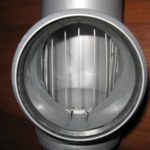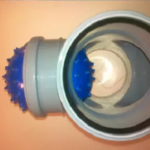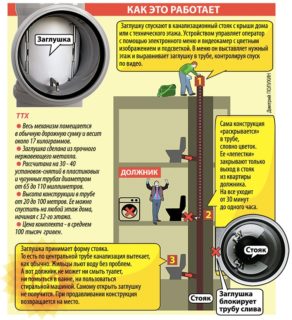In the fight against utility debt, management companies use tough methods. To get people to pay their water bills, they shut off the sewers using special plugs. But if there is no money for a communal apartment yet, you can remove the device yourself, and it is quite legal.
Appointment of a stub for debtors
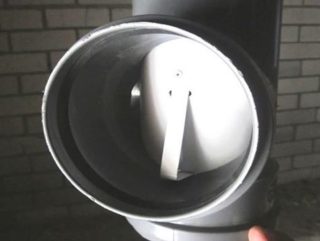
If a person does not pay for the water supply in a timely manner, it is perfectly reasonable to stop supplying him with this utility service. However, in apartment buildings, the fluid supply is carried out through the common building riser, which means that you will need to block it completely. But after all, respectable payers live in the entrance.
It is possible to stop the supply of water for a certain apartment only inside it, but the owner has the legal right not to let the controllers in.
Utilities specialists have found a solution - to block the sewer pipes to debtors. This is real for a separate apartment and is done by means of a plug - a valve that closes the drain hole between the common house riser and the private drainage network.
Installing a jamming part will not cause problems for respectable residents. It is placed in such a way that the sewage system is blocked only for a certain apartment. Usually, the installation of the device leads to the fact that debts are paid after two to three days. After that, the utilities return the riser to its previous appearance. However, there are exceptions. For various reasons, homeowners decide to remove the plug themselves - there are plenty of methods for this.
Legality of installation and self-removal of plugs
In general, the installation of such devices does not contradict the law. However, before installation, the management company must send a letter notifying of the restriction of sewerage services so that the owner is aware of the upcoming problems. The most savvy defaulters, having received such a document, prevent the installation of a plug valve. They put an anti-plug on the sewer pipe. For these purposes, a through pin or bolt is used. An anti-plug is inserted slightly above the tee and prevents the valve from being mounted.
If a warning was not given to the owner of the home, the legality of installing a plug on the sewer riser for debtors can be challenged in court.
It is easier and faster to simply remove the interfering device. In matters of the legality of such actions, the law is on the side of the residents. After all, the valve creates a blockage in the sewage system, which must be eliminated.
Experienced defaulters recommend not to remove the plug immediately after it appears, but to wait until the pipe clogs up a little. After that, the legality of actions to clean it up will be undeniable.
Types of devices and principle
The sewage system is closed using valves of three types:
- Solid. Such valves completely shut off the drain flow into the central sewerage system.
- Lattice. They allow liquid effluent to pass through, and solid waste accumulates on the surface.
- Pneumatic plugs. The complete shut-off of the pipeline is carried out by pumping compressed air into the device, which then looks like a rubber ball.
It is difficult to say which valve will be installed by housing and communal services specialists.It depends on the layout of the highway and the financial capabilities of the management company. Solid plastic valves have the lowest price, so they are more likely to be installed.
Valve installation
Further actions are as follows:
- Carrying out accurate calculations of the location of the drain hole from the apartment.
- Lowering the manipulator from the roof with a fixed plug into the desired hole in the common sewer riser.
- Finding the necessary "fork" by means of a monitor and LED.
- Inserting a plug into the side opening of the system.
After that, it remains to get the equipment out of the pipeline and report to the authorities, and to the management of the Criminal Code - wait for the debtor to come to pay the bills. Only after that, the utilities will remove the plug from the sewer riser if the homeowner does not solve the problem himself.
Methods for removing plugs
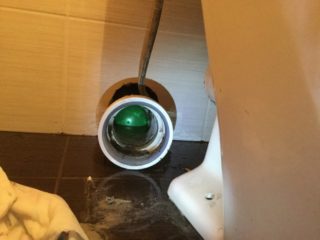
The easiest way to get rid of the problem is to pay the bills. After that, the utilities will remove the plug. But even after payment, there is no guarantee that the plumber will come the same day. How long you will have to wait for it is unknown, and the blockage in the pipe will worsen, exuding a stench. Therefore, those who paid off the debt also sometimes decide to remove the plug from their sewer on their own. For this, the same methods are used as for eliminating blockages.
Removal with a plunger and plumbing cable
Using these tools is the easiest way to remove the plug yourself. To do this, you need to determine its location. This can be learned by tapping the pipes. A dull sound speaks of filled places, and a ringing sound speaks of empty ones.
Then proceed like this:
- Open the water in the plumbing fixture closest to the valve and wait for it to drain.
- Place the plunger over the drain grate.
- Do some pumping to build up pressure in the pipeline. The water is not compressed, which will cause the plug to be pushed out of the pipe by the stream.
If the installation of the valve is not too high-quality, the plunger is enough to solve the problem. But the part can get stuck in the main pipe, after which all residents will not be able to use the sewage system.
If the problem is not solved with a plunger, you can use a plumbing cable. This is the ideal method for dealing with pneumatic valves. A hole is punched in it, into which the hook is inserted. With little effort, the device is removed from the pipeline. However, it is not difficult to hook up and pull out the grate with a hook.
Dismantling the toilet
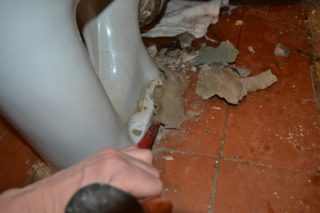
Using this method is only possible if the plumbing is fixed to the floor with bolts. If the toilet is of the old model, the installation of which was carried out on a cement-sand mortar, this option disappears due to inappropriateness, unless replacement is planned. After dismantling, it simply will not work to install the plumbing in place.
Dismantling takes place as follows:
- Shut off the water supply.
- Remove the reservoir and disconnect all communications.
- Unscrew the bolts, move the toilet and get to the outlet in the common riser. Typically the location of the tap allows you to reach and remove the inserted plug. If the obstacle is located near the entrance to the inter-apartment pipeline, it is pulled out by grabbing it with pliers.
It is strictly forbidden to push the plug into the common riser, as this will aggravate the problem. A part can clog a common pipe and create a problem not only with utilities, but also with neighbors. Therefore, the obstacle on the way of sewage drains should be removed only to your apartment.
If cement mortar was used when installing the toilet, but there is an inspection hatch nearby for cleaning the pipeline, you can use it. Removing the cover will be more difficult.To remove the obstruction, you will need a plumbing harpoon or an ordinary long stick with a hook attached to the end.
The procedure is as follows:
- Open revision.
- Insert the prepared hook or harpoon.
- Hook up the plug.
- Push her into the riser.
Before that, you should worry about your safety. You need to put on a warm shirt and rubber gloves, after wrapping your arms up to your shoulders with plastic. In the process of work, not only feces, but also boiling water can come down from the neighbors on top.
It will not be difficult to pull out a part from polypropylene or mesh, but this technique has a number of imperfections. There is a danger of dropping the broken plug and blocking the common riser with it. The difficulty lies in the fact that all actions are performed blindly.
Chemical cleaning

The household chemicals market presents a large assortment of sewage cleaning products containing hydrochloric or oxalic acid. They can be used to eliminate the stub. This method will bring a minimum of hassle, but the chances of success are much less:
- The formulations only affect metallic varieties.
- There is a risk that the chemicals will corrode not only the barrier, but also the pipe itself.
- The result will appear in a few days, or even a week - that is, the elimination of the problem will be postponed.
Plastic solid valves and pneumatic plugs must not be removed with chemicals. For their manufacture, materials similar to pipe materials are used. A large amount of "vigorous" chemistry will destroy not only the valve, but also the pipes throughout the sewage system. Repairing it will cost more than debt.
If you cannot solve the problem, you can dismantle part of the sewer pipeline and get to the desired place. Or seek help from specialists.
Such a service will easily be provided by the same private plumber, since the owner of the home is solely responsible for the condition of the sewer pipes. The prices for professional removal of the plug from the sewer depend on the complexity of the work. The average cost of removing a part by a specialist is from 500 to 2500 rubles.
Installing a plug for non-payment of a communal apartment is not illegal. But at the same time, such actions can be challenged in court. Removing an obstacle on your own is quite difficult - you need to have plumbing skills. Easier to pay debts. In addition, it should not be ruled out that after the elimination of the plug, the utilities will supply a new one.

